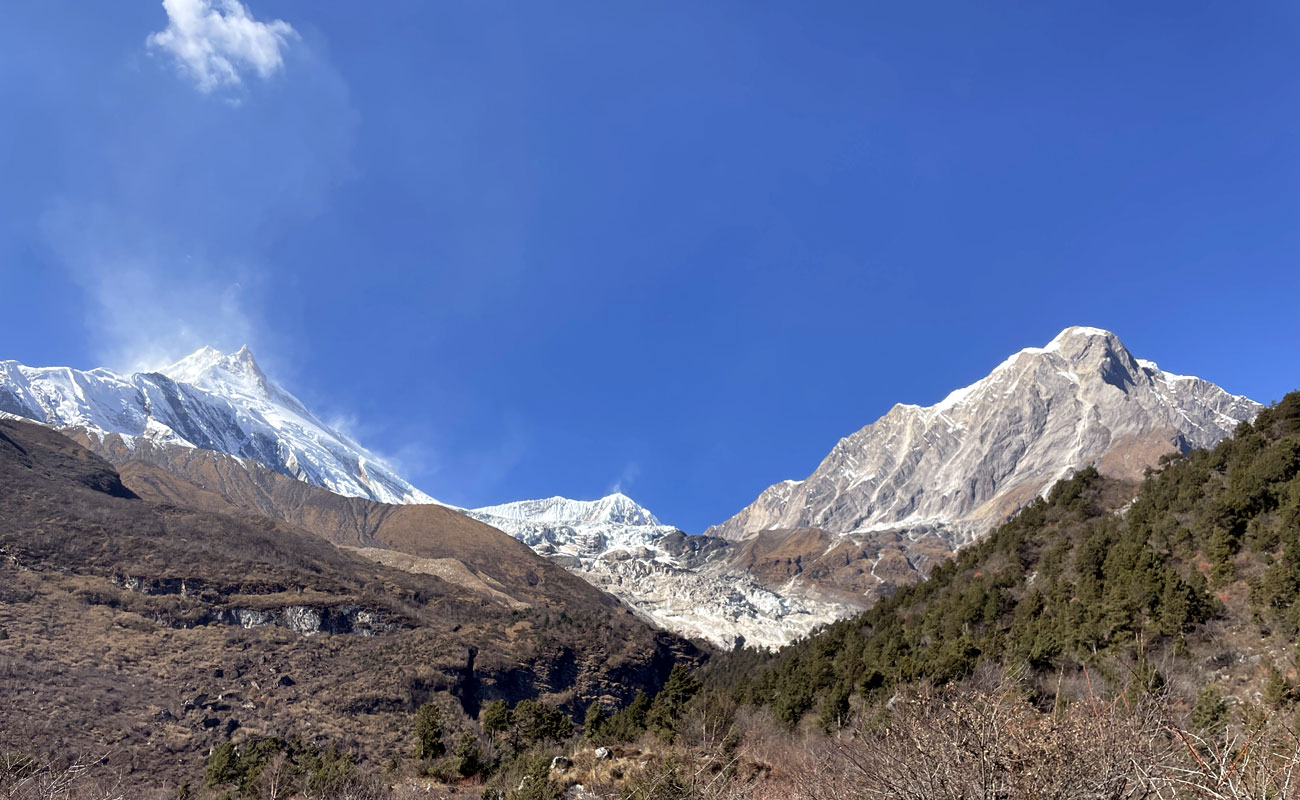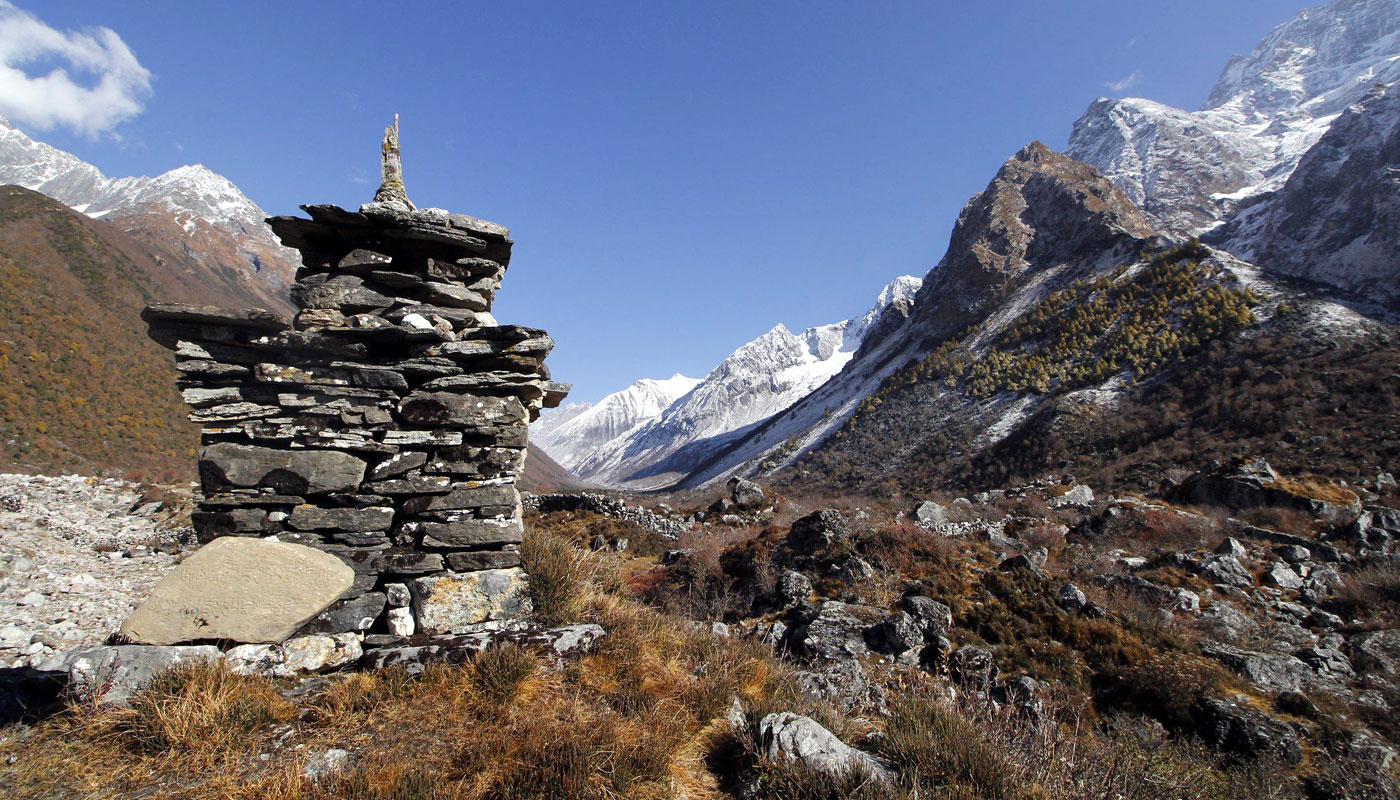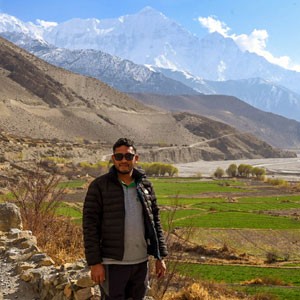Few places on earth feel as wild and alive as Larky La Pass. Perched at 5,106 meters above sea level on Nepal’s Manaslu Circuit trek trail, this high mountain saddle tests your stamina, rewards you with jaw dropping panoramas, and leaves you with memories that last a lifetime. This is also the highest pass in the world. In this blog, I’ll share what makes Larky La so special, how to get ready, and a handful of tips.
Larky La Pass is more than just a high point on a map, it’s an experience that unfolds in layers, day by day. You’ll start your approach in Bhimtang, a quiet meadow camp at about 3,700 m, where prayer flags flutter on gentle slopes. From here, the trail angles upward through fields of bright-yellow rhododendron and scraggy juniper, crossing small streams fed by distant glaciers. As you climb, the air thins and the landscape grows sparse, until at last you stand beneath the looming moraine walls of the Larky Glacier itself.
The final push to the pass begins before dawn. Your headlamp cuts through cold, still air as you step onto a narrow, snow packed ridge. Each breath is hard won; each step a small victory. Around you, the giants of the Himalaya rise like silent sentinels: Himlung Himal to the west, towering Annapurna II ahead, and the spiky summits of Cheo Himal on your right. The world feels hushed, as if holding its breath while you make your way upward.
Reaching the saddle at roughly 5,100 meters is a moment of pure magic. The sky is a deep, unmoving blue; the air so clear you can see half a dozen snow capped peaks in every direction. Prayer flags mark the spot, their colors faded by wind and sun, sending silent blessings into the thin mountain air. You’ll linger here, perhaps for ten or fifteen minutes, snapping photos and letting the enormity of it all sink in, before turning to begin the long descent.
On the way down, your legs may burn a little but your heart is full. You’ll pass through the ice carved valley, stepping carefully over meltwater streams, until the tundra gives way to shrubs and finally to a shady forest of birch and fir. By the time you reach Dharmasala, the camp below the pass, the sun is low and the air warms with the promise of tea and warm blankets. In every aching muscle and every memory burned into your mind, Larky La remains wild, alive, and unforgettable.

What Makes Larkya La Pass So Unique?
Every trekker dreams of summiting a high pass, but Larky La has a spirit all its own. Unlike crowded trails elsewhere, you’ll often find stretches where it’s just you, the wind, and the silent peaks. From the steep climb at dawn to the sunrise hitting the ice walls, there’s an almost sacred hush in the air. And at the top, you’re rewarded with a view that puts every step into perspective. It feels like being on top of the world only quieter.
There’s something almost reverent about Larky La that sets it apart from any other high mountain crossing. Here, you’re not just following a well trodden route but carving your own path through silent, wind swept slopes. In the pre dawn cold, the world feels paused, only the crunch of your boots on frost hardened gravel and the steady rhythm of your breath break the stillness. As first light seeps over the horizon, you’ll catch the glacier’s ice walls glowing in soft apricot hues, and for a moment it feels as though the mountains themselves are greeting you.
The ascent is steep: each step tests your strength; each breath reminds you how high you are. But there’s an intimacy here you won’t find on busier treks the chance to press your palm against a prayer flag pole and watch the colors dance in the wind, to pause on a rocky perch and study the serrated ridges of Annapurna II as if for the first time. When you finally crest the saddle at 5,100 meters, the reward isn’t just the panorama, but the hushed triumph of having climbed here in near solitude.
On the far side, as your legs begin the long, careful descent into the valley, you carry more than sore muscles you carry a quiet joy that comes from earning every meter of that climb. Below, the forest slowly reclaims the barren highlands, birch and fir softening the landscape. And by the time you reach camp, warmed by tea and sunshine, you know you’ve shared a secret moment with some of the tallest peaks on Earth untouched, breathtaking, and utterly Larky La Pass.
A Step by Step Route Overview
Most trekkers start the Manaslu Circuit at Soti Khola, winding through terraced fields and dense forests. Here’s a simplified breakdown:
Soti Khola to Maccha Khola (7 km)
Gentle riverside trails give way to dramatic gorges. You’ll cross suspension bridges and pass local tea stalls.
Maccha Khola to Jagat (8 km)
Villages here look straight out of a storybook: stone houses with prayer flags draped overhead.
Jagat to Deng (10 km)
The trail grows steeper. Pine forests open up to views of Himlung Himal.
Deng to Namrung (12 km)
Now you’re climbing. Don’t rush. Let your legs and lungs sync with the slope.
Namrung to Samagaun (4 km)
Cross a wooden bridge, then arrive in a village that feels almost Tibetan. Cloud streaked mountains tower above.
Sama Gaun to Samdo (8 km)
A short day to aid acclimatization. Enjoy yak herds grazing on alpine meadows.
Samdo to Dharmsala/Larky Phedi (6 km)
Winds pick up here. The landscape turns lunar rock and ice as far as the eye can see.
Dharmsala to Larky La to Bhimtang (16 km)
This is the longer day. Pre dawn departure, a steady five to seven hour climb, then a long descent on the other side.
What Lies Beyond the Pass?
Beyond the pass, the world seems to soften under your boots. Gone are the jagged moraine walls and snow packed ridges; in their place, the trail slopes gently into a lush valley where pale green grasses sway in the afternoon breeze. Wildflowers edelweiss, blue gentians, and tiny white primulas pepper the meadow, nodding their heads as you pass. Bhimtang appears like a mirage of stone and wood: snug lodges clustered around prayer flags, smoke curling from chimneys, and yak caravans lumbering by with their bells tinkling in the quiet air. Here, the mountain’s roar dwindles to a whisper, replaced by birdsong and the soft murmur of a glacier fed stream winding its way downhill.
If your legs still have gas in them, set out on the little path just past the village that leads to the hot springs. Steam rises from natural pools carved into granite, and sinking into the warm water under a sky still dusted with snow capped peaks feels like a reward written into the landscape itself. Mineral tinged waters ease every ache, and as you soak, you can’t help but smile at how far you’ve come from the icy saddle of Larky La to this humble alpine oasis. With a cup of butter tea in hand and the mountains framed all around, you’ll realize that the real adventure doesn’t end at the pass it blossoms in every step that follows.

Challenges and difficulties while crossing Larkya La Pass
Tackling Larky La isn’t a walk in the park. The pass sits up at 5,106 m (16,752 ft), so thin air is your first foe. Even if you’ve been on high trails before, your lungs will burn and each breath feels shallow. You’ll need solid acclimatization slowly climb, rest, drink plenty of water. Push too fast, and a pounding headache or nausea can knock you sideways.
The trail itself can be brutal. One moment you’re picking your way over loose scree, the next you’re lunging up steep switchbacks. Your boots sink into gravel that slides underfoot. On the descent, the trail turns into a narrow ribbon where one slip means a long tumble. Trekking poles help, but you’ve got to stay focused every step of the way.
Weather up there is anything but predictable. Clouds can roll in and dump snow without warning. Mornings often start clear and calm, but by midday wind gusts can whip snow into your face. Temperatures swing wildly icy mornings, sunbaked afternoons. You’ll layer up, then peel off, then layer up again, all while trying not to overheat or freeze.
Mentally, it’s a big ask. Expect a ten-to-twelve-hour push on summit day, most of it before dawn. You’ll haul a heavy pack, fight fatigue, and ignore that nagging voice saying, “This is too much.” Snacks and short breaks keep morale up, but at times you’ll just have to grit your teeth and keep moving.
Finally, remember you’re deep in the Himalaya help is a long way off. Cell signal vanishes, rescue teams take hours (if not days) to reach you. That means planning for extra days, carrying emergency gear, and trusting your guide. It’s tough, yes, but conquer these challenges and you’ll stand on Larky La with one unforgettable story to tell.
Suitable season for Larke La Cross
Plan your Larke La trek in either late spring (late April–early May) or autumn (late September–mid-October). That way you’ll have the most stable weather, the clearest views, and trail conditions that let you focus on your pace and breathing not slogging through mud or waist-deep snow. You can only safely cross Larky La in two windows of the year spring and autumn. Outside these you’ll run into heavy snow, rock fall or monsoon downpours.
Spring (Mid-March to Mid-May)
Weather: Generally clear skies, warming temperatures by late April. Nighttime can still be around −5 °C at the pass, but daytime climbs into single-digit positives.
Trail conditions: Most of the snow from winter has blown off or begun melting, so the route is cleaner than autumn; however, late-season snowstorms can still dump fresh powder.
Pros: Blooming rhododendrons lower down, fewer trekkers than autumn, views are sharp after winter’s scrub.
Cons: Meltwater streams can swell, making some crossings tricky; occasional snow on the high flanks.
Autumn (Mid-September to November)
Weather: Post-monsoon skies are usually the clearest of the year. Days are cool (0 °C to 10 °C at altitude), nights steadily dropping toward −10 °C by November.
Trail conditions: Sun-baked and dry underfoot, so loose scree is the main concern rather than deep snow.
Pros: Superb visibility of peaks, stable weather patterns, less water-related trail erosion.
Cons: Camps can get crowded; temperatures plummet quickly after sunset.
Why not the other seasons?
Monsoon (June–Mid-September):
- Trails below the pass turn into rivers of mud. Above 4,000 m you’ll often be slogging through wet snow, and rock fall risk rises sharply.
Winter (Late November–February):
- Deep snow seals the upper pass for all but highly technical, expedition-style crossings.
- Temperatures can dip below −20 °C, and help is very hard to reach.
Tips for a Smooth Trek
- Go slow as the altitude isn’t your friend.
- Carry snacks like nuts, chocolate, and energy bars kept your spirits high.
- Respect the weather. Winds can whip up fast. Be ready to hunker down.
- Carbon monoxide caution. In tight lodges, make sure there’s ventilation when you warm up by the stove.
- Pack a micro fleece or buff. That morning chill will bite harder than you expect.
Gearing Up: Preparation Matters
Gearing Up
Clothing
- Base layer: A couple of quick-dry tees and bottoms. They keep you dry and cut down on washing.
- Mid layer: A fleece or light puffy jacket. Warm, but not bulky.
- Outer shell: Waterproof, breathable jacket and pants. Rain can hit any day.
- Insulation: A down or synthetic jacket for evenings at high camp.
- Gloves: One thin pair for walking, one thick pair for camp.
- Hat & buff: A warm beanie + a buff you can pull over your nose.
Footwear
- Trekking boots: Broken in, waterproof, ankle-supporting. Test them on hills before departure.
- Camp shoes: Lightweight hikers or sandals to give your boots a rest.
- Socks: Merino or synthetic, two pairs per day. Change often to avoid blisters.
Packs & Bags
- Main pack (50–65 L): Big enough for layers, camera, snacks.
- Daypack (20–30 L): For water, layers, snacks lightweight and comfy straps.
- Sleeping bag: Rated to –10 °C (14 °F) or colder.
- Stuff sacks: Keep gear organized and dry inside your pack.
Essential Accessories
- Trekking poles: Save your knees on steep ups/downs.
- Headlamp + extra batteries: Early starts and late dinners.
- Water bottles / bladder: Aim to carry 2–3 L capacity.
- Water treatment: Tablets or filter don’t rely on unpurified streams.
- Sunglasses: UV-protected, wraparound style.
- Sunblock & lip balm: High SPF, reapply often.
- Basic first-aid kit: Blister care, painkillers, altitude-sickness pills if you use them.
Physical Preparation
Cardio build-up
- Start 8–12 weeks out.
- Mix long hikes (3–5 hours) with stair-climbing or incline treadmill sessions.
Strength work
- Focus on legs and core: squats, lunges, planks.
- Two workouts per week.
Back-to-back days
- Simulate trekking fatigue by doing moderate hikes on consecutive days.
Acclimatization practice
- If you can, spend a night at altitude beforehand.
- Arrive in Kathmandu a few days early to rest.
Trip Planning & Tips
- Permits: You’ll need the Manaslu permit and TIMS card. Sort these at Katmandu or via your operator.
- Guide & porter: Strongly recommended above 5 000 m. They carry loads and navigate snow/rock.
- Daily stages: Plan no more than 4–6 hours walking above 4 500 m. Give your body time to adjust.
Hydration & nutrition
- Drink at least 3–4 L per day.
- Snack constantly: nuts, bars, dried fruit.
- Enjoy hot soups and dal bhat for proper calories.
Final Thoughts
Larkya La Pass is a journey into raw mountain beauty and personal limits. You’ll face thin air, steep slopes, and rocky paths, but every hard step leads to a view and a feeling you won’t find elsewhere. If you crave solitude, challenge, and the chance to stand among giants, this trek is calling your name. Lace up your boots, breathe deep, and let the mountains work their magic.
This is the highest point on the Manaslu Circuit and the heartbeat of your trek, where every aching muscle and every ragged breath becomes a testament to your resolve. Here, amid swirling prayer flags and an endless array of snow capped summits, you’ll discover a quiet strength you never knew you had.
Whether you’re tracing your steps through wildflower studded meadows or standing atop the icy saddle at dawn, the magic of Larky La lies in the journey as much as the view. Lace up your boots, answer the call of the mountains, and carry home more than photographs you’ll return with a story of challenge met, limits pushed, and a heart forever tethered to the Himalaya.



